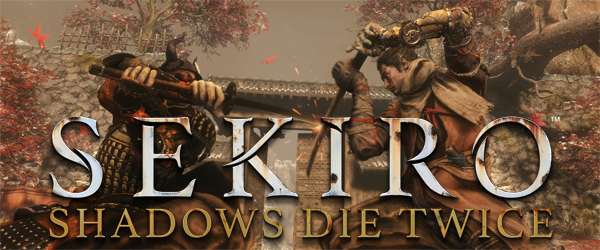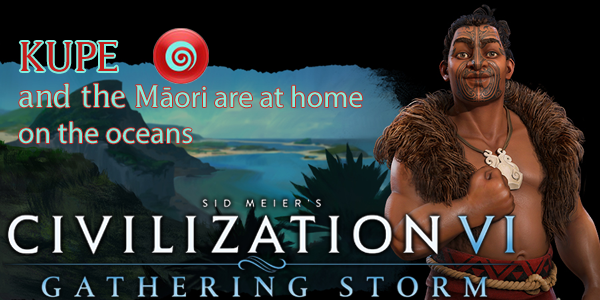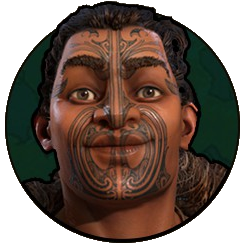
I never got into Tenchu because the
demos were too hard for younger me.
Oh, boy, was this a tough game to play and review! Frequent readers should probably know that I'm a huge Souls-Borne fan -- to the point of writing strategies and lore analyses. Sekiro is a bit different, however. It's much further divorced from Dark Souls than even Bloodborne was. Despite the lack of "Souls-Borne-ness" of Sekiro, I find it very difficult to put this review in any context other than of a new Souls-Borne release.
Sekiro is, ostensibly, a stealth game. There's more of Tenchu and Metal Gear in Sekiro than of Dark Souls. That's not necessarily a bad thing. I like stealth games just fine. The Metal Gear Solid games rank among one of my favorite game series ever.
I'm not terribly familiar with Tenchu, though. I think I played a demo of a PSX Tenchu game on one of my Official PlayStation Magazine demo discs (back in the day when publishers let players play pre-release demos, for free, instead of expecting us to pay for games long before they're even released, or holding the "open beta" hostage to a pre-order). I never bought the full Tenchu game because the demo was far too hard for my little 13 or 15-year-old gamer skills to handle. This was, of course, long before I started playing more demanding games.
Sekiro is in an awkward juxtaposition between Tenchu-inspired stealth, and Dark Souls-inspired boss fights.
However, there seems to be a certain degree of juxtaposition between Sekiro's desire to be a Tenchu-like stealth game, and its desire to feature demanding boss fights in-line with what is given in Souls-Borne games. In essence, we have two games here: a stealth game about staying out of sight of enemies and picking them off one-by-one; and a melee boss gauntlet in which the stealth isn't applicable at all. The first of those is good enough. The second one is where my problems begin...
My first playthrough of Demon's Souls was spent
cowering behind a shield.
All parry, all the time
You see, this really comes down to play-style. I was never a big parry-er in my Dark Souls-playing days. I parried a lot more in Bloodborne, but a big reason for that was that the guns allowed me to do so from a relatively safe distance. Heck, my first playthrough of Demon's Souls was done as the Royalty class, starting with the mana-regen ring, stabbing out with a winged spear from behind a shield, and using Soul Spear to dispatch any enemies I wasn't comfortable fighting up close. I hardly realized the parry mechanic existed!
Of course, I've grown and matured since 2008, and parrying has become a common element of my play-style. But I've still never been particularly good at it. This is causing me a lot of trouble in Sekiro because Sekiro's combat is all parrying, all the time! The new posture mechanic (which essentially replaces stamina) also means that a single parry isn't good enough to riposte and kill your enemy. You have to parry each strike in flurries of blows. For those coming from Dark Souls, imagine having to fight a hollow undead, and needing to parry every one of its wild slashes before you can riposte, instead of just the first one. That is what Sekiro expects and requires you to do.
Sekiro requires that you parry most attacks.
If you were a master-level parry-er in Dark Souls III, then you'll probably segue right into Sekiro with no problem and wonder what all the fuss is about. But for the rest of us plebs, that isn't going to be so easy.
This game plays much faster, enemies are much more aggressive, and health is in much smaller supply. Almost everything will kill you with two hits, and many grab attacks will drop you from full health to zero. This game leaves you with virtually no margin for error! Yet the mini-bosses and bosses have ridiculously high HP and posture.
... [More]
ecd29173-9c96-446a-944a-ddc20d5687ab|1|5.0
Tags:Sekiro, Sekiro: Shadows Die Twice, From Software, Activision, Hidetaka Miyazaki, Tenchu, Dark Souls, Demon's Souls, Bloodborne, stealth, boss, Japan, shinobi, samurai, mythology, lore, parry, deflect, deathblow, grinding

Civilization VI's second expansion, Gathering Storm recently released and has added a handful of new civilizations and leaders. I am hoping to write a strategy for each of them, but I want to start with the civilizations and leaders who are completely new to the franchise. This time, I'll be writing about one of the more interesting of the new civs and leaders: the Māori, lead by Kupe the Navigator.
Natives of the Polynesian Triangle are some of the most successful sea-faring peoples in the history of the world. Between 1400 BC and 900 BC, they had begun sailing large ocean-going craft called "waka", that enabled them to cross from Taiwan, through the Philipines, and out to the Melanesian and Samoan islands. Over the next two thousand years, they managed to colonize Pacific islands as far as Hawai'i, Easter Island, and New Zealand. Some historians even believe that they made it as far as the coast of South America! Sometime in the 13th or 14th century, settlers from Polynesia sailed west, began colonizing New Zealand, conquered the local tribes, and began to culturally diverge from their Polynesian ancestors to become the Māori.

According to legend, the first Polynesian to arrive in New Zealand is Kupe the Navigator, chief of Hawaiki. Kupe is figure in Māori mythology, but like Gilgamesh, Hiawatha, and others, he is believed to be an actual historic figure. Historians have constructed accounts of Kupe's life that differ from the various oral legends of the Maori and Polynesian peoples. According to legends, Kupe sailed from Hawaiki (the mythological birthplace of the Polynesian people), along with great migration fleets, to colonize New Zealand as far back as antiquity, battling sea demons along the way. According to historians, Kupe probably found New Zealand between 750 AD and 925 AD after his cousin drowned on a fishing trip and Kupe fled across the sea with his cousin's kidnapped wife, only to return to Hawaiki later to convince others to migrate to the newly-discovered lands with him.
DISCLAIMER:
Civilization VI is still a "living game". Strategies for the game (and for specific leaders and civs) may change as Firaxis applies balance patches, introduces new features, or expands the game through further DLC or expansion packs, or as the Civ community discovers new strategies or exploits. As such, the following strategy guide may change from time to time. I will try to keep it up-to-date, and will make notations whenever changes are made. I'll also post links in the official 2K forums and CivFanatics, where I'll also report any changes made. If possible and practical, I will try to retain the original content of the strategy for posterity.
I welcome any feedback or suggestions that readers wish to offer. Feel free to post on the linked forums, or by posting a comment at the bottom of the page.
This guide is up to date as of the release of the Gathering Storm expansion's "Great Works and Trade Update" (April 2019) (ver. 1.0.0.317)
Māori are a sea-faring and environmentalist-focused civilization. They can embark and sail across ocean from the beginning of the game, and they get extra yield from unimproved feature tiles. [More]
561fb1a8-9d2a-4002-b81e-1df2c98f29d0|0|.0
Tags:Sid Meier's Civilization, Civilization VI, Civilization VI: Gathering Storm, Maori, Kupe, mana, Kupe's voyage, marae, toa, pa, fort, ocean, embark, forest, rainforest, harvest, resource, unique building, unique melee unit

I finally got around to playing some games of Fantasy Flight's second edition of the X-Wing Miniatures Game. I had bought the 2.0 core set and the 1.0 conversion kits back in October of last year. I was on the fence about purchasing 2nd edition. The only change that I was really excited about was the new turret rules, which I figured I could easily house-rule into 1st edition. However, I used my girlfriend's teacher discount at Barnes & Noble along with a coupon to get a hefty discount on the 2.0 core set and conversion kits, in the hopes that the game's other changes would also make it worthwhile.
Older ships have new abilities,
and tokens flip to a "spent" backside.
Fantasy Flight took the opportunity to streamline many components and add some ease-of-use features. For example, the maneuver dials are redesigned such that you can see every maneuver that the ship has available without having to rotate the dial. Upgrade cards have large, empty spaces that allow you to slot them underneath their respective pilot's card without covering up important information. Ship bases and maneuver templates have handy guidelines that can be helpful when executing partial maneuvers (due to collisions). And so forth.
Tokens have been broken up into different colors, each of which has a different effect. All green tokens (such as "focus" and "evade") are now buff tokens which are removed at the end of the round (unless a card says otherwise). Orange tokens are de-buffs (such as "disarm") that go away at the end of the round. And red penalty tokens (such as "ion" and "stress") remain in play until a certain condition removes them. Shield tokens now have a back side, which is colored red. This way, you can flip a shield token over when it's spent, but keep it on your ship card in case it ever gets recharged. The new energy and force tokens work the same way.
Better still, many features, concepts, and abilities from later expansions to 1st edition have been back-ported to all ships in 2nd edition. This has certainly increased the value of simple X-Wings, Y-Wings, and many other early 1st edition ships. The titular X-Wings, for example, now have a barrel roll ability on its card and a Talon Roll on its maneuver dial. The Lambda shuttle is one of the most improved ships in second edition, as it now has both a fore and aft-facing firing arc, as well as new "coordinate" and "jam" actions.
I appreciate that expansion ships are sold in smaller, more efficient packaging.
Heck, even the packaging is more streamlined. The massive boxes for 1st edition's large ships (which were full of empty space) have been replaced with smaller plastic bubble-packaging.
... [More]
fcf863f3-cbb8-458e-84ab-83449a8a4d74|3|2.3
Tags:Star Wars, Star Wars: X-Wing, Star Wars: X-Wing 2nd edition, miniatures, miniatures game, board game, Fantasy Flight, Extrebit, squadron builder, app, companion app, squad points, tournament
If you're a fan of college sports video games, then you've probably already heard that in the middle of May, the NCAA announced that it would be convening a special group to re-examine the issue of student-athlete compensation for the use of their name and likeness. Lawsuits from former players whose likenesses were being used in college games without their permission (let alone compensation) is the reason that companies like EA and 2K Sports had to stop releasing new college football and basketball games back in 2012 and 2013.
These issues have been in and out of the courts over the years, with most (if not all) cases being decided in favor of the individual athletes and requiring the NCAA, video game publisher, or both to have to pay damages the athlete. Ever since, the NCAA has refused to lend its license to video games in particular, as they have steadfastly refused to allow players to be compensated on the grounds that they are "amateur" student athletes, even though they are the primary driving force of a multi-billion dollar-a-year industry.
College sports games have been absent for quite a few years now.
Over recent years, the NCAA has been receiving mounting public pressure to pay athletes and/or allow them to profit from the use of their likeness in commercial products, and it looks like they might finally cave to this pressure later this year. We've talked about the idea of college sports games returning in the past, but up till now, it's always been purely speculative. This time is a bit different, however, since the NCAA itself is finally taking some actual action on the topic. No final decision will be reached until October, so it's still entirely possible that the committee will decide to retain the status quo, which will mean no NCAA-licensed video games in the foreseeable future.
I already thought 2020 was shaping up to be a good year for football video games,
even before this announcement from the NCAA!
I am optimistic that the NCAA will decide in favor of allowing players to receive compensation. In fact, I think this could actually be a brilliant -- and somewhat insidious -- decision by the NCAA. On the one hand, it allows them to license their brand to video game, which would provide a revenue stream for the NCAA. Secondly, it allows the players (the popular ones, anyway) to get paid, which may quell much of the popular demand for the NCAA themselves to pay athletes a salary.
Lastly, based on what I've read about the proposed rule changes, the deal would allow the license-holder of the game or the manufacturer of the paraphernalia holding the athlete's likeness and/or name to pay the athlete directly. Which means the NCAA isn't actually the one paying the athletes. The athletes are getting paid with someone else's dollar. It would, thus, allow the NCAA to save face by continuing to pretend that they are facilitating an "amateur" sport".
In fact, the NCAA's official statement flat-out says:
"... the group will not consider any concepts that could be construed as payment for participation in college sports. The NCAA’s mission to provide opportunity for students to compete against other students prohibits any contemplation of pay-for-play."
It's a kind of cop-out win-win-win for the NCAA, so it's actually kind of amazing that they didn't consider doing this sooner.
... [More]
0a12818a-150f-4219-9a9d-306fc8c07461|0|.0
Tags:NCAA, college football, college basketball, NCAA Football, College Hoops 2k, Electronic Arts, EA Sports, 2K Games, ultimate team, student athlete, lawsuit, compensation, Ed O'Bannon
Last week, just in time for the announcement (and release) of a new expansion for Cities: Skylines, I posted a video analysis on YouTube discussing what I perceive as weaknesses in the modular design philosophy behind Skylines' myriad expansion packs. The full video is available on YouTube (and embedded below), but I've also transcribed the text in blog form for those who may prefer reading over watching/listening.
The video is up on YouTube.
I want to start out by saying that I love Cities: Skylines. Skylines is -- without a doubt in my mind -- the single best city-builder since SimCity 4, which released in 2003 (over 15 years ago, as of the time of this recording). When I watched the first trailer for the game, in which the player apparently custom-builds freeway ramps and interchanges from scratch (at about 40 seconds into the trailer), I was sold on this game! After years of having to use boring, pre-fabricated stock on-ramps and interchanges, the little civil engineer withing me practically jizzed in his pants at the idea of being able to build my own highway ramps and interchanges! And there was no looking back.
Cities: Skylines gloriously succeeds where games like SimCity (2013) and Cities XL miserably failed. It picks up the mantle of the great SimCity games of yester-decade, and brings it into the 21st century with deep simulation based on agents, a sleek and modern UI, extensive customizability and moddability, and an attractive 3-D graphics engine. It's made all the more impressive by the fact that the game's developer, Colossal Order, is a small, independent studio that had something like nine people working for it when the game initially launched. And a company with all the manpower and resources of Electronic Arts only managed to produce a flop like SimCity 2013.
... [More]
cdac9d28-8482-4449-a673-ff10d4b7cc87|0|.0
Tags:Cities: Skylines, Cities: Skylines: After Dark, Cities: Skylines: Snowfall, Cities: Skylines: Natural Disasters, Cities: Skylines: Mass Transit, Cities: Skylines: Green Cities, Cities: Skylines: Parklife, Cities: Skylines: Industries, Cities: Skylines: Campus, Colossal Order, city planner, city simulation, strategy, Steam, Paradox Interactive, expansion, YouTube, Sid Meier's Civilization, Civilization V, Civilization V: Brave New World, Civilization VI, Civilization VI: Rise and Fall, Civilization VI: Gathering Storm
|

| 12 | | | | | | | 60 | | 11 | | | | | | | 55 | | 10 | | | | | | | 50 | | 09 | | | | | | | 45 | | 08 | | | | | | | 40 | | 07 | | | | | | | 35 | | 06 | | | | | | | 30 | | 05 | | | | | | | 25 | | 04 | | | | | | | 20 | | 03 | | | | | | | 15 | | 02 | | | | | | | 10 | | 01 | | | | | | | 05 |
|